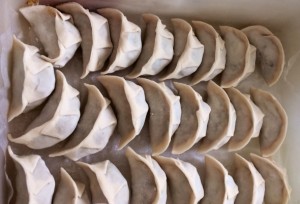Dumplings, A Symbol of Love
By U-Jin Lee
I was five years old and my grandma was flailing her arms, chasing me around with a dumpling in her hand. “U-Jin, have one more bite…please, just one more!”
I’d hide behind the giant fish tank in her apartment and peek in between the fish to see where she was, and then when she was near, hide again as fast as I could. At that time, I despised eating. I had no patience to calmly sit down and eat—there was not enough time during the day to waste it on eating. Having zero attention span didn’t help either.
As my mom describes it, I was a skinny, hyperactive child who couldn’t stay still for more than 5 minutes. From the moment I could walk, I’d sit and stand, then sit and stand again, and this would go on for the whole day and drive my relatives crazy.
“But I don’t want to eat, please! I’m full already,” I whined as my grandma shoved another dumpling in my mouth.
All of my family members were worried about how little I was eating. At that time, I considered eating a chore. Consuming food for pleasure just didn’t make any sense.
But with my grandma’s unconditional love nurturing me, everything changed—especially my love for food.
Until I was five years old, my grandma was my second mom. While my parents were on business trips or busy at work, I stayed at her apartment in Seoul, Korea. When I wasn’t with her, I’d wake crying to my mom in the middle of the night, asking for my grandma. My love for her is indescribable and just too deep for words.
My grandma’s way of getting me to eat was simple: sit me down and allow me to play with the ingredients. While many parents highly advise against letting their children play with food, my grandma completely encouraged it.
Our menu every Saturday: homemade dumplings.
Often times, I plopped in a chair and watched my grandma make dumplings. In front of her were: flour, a bowl of water, ground beef, scallion, salt, pepper, tofu, and kimchi. First, we’d prepare the filling in bulk. I’d put the ground beef into the bowl and season it with salt and pepper. Then, I’d chop scallion, tofu and kimchi in the pot and mix it all together. When I finished, I’d push the fillings to the side. The most fun part came at the end—preparing the dough.
The most important part of making a dumpling is to get the consistency of the dough just right. With too much water added to the flour, the dough can get too sticky, and with too little flour, it can be too dry. My grandma knew just the right amount to put in, and that, she says, comes with lots of experience.
When the dough was perfect, she’d rip a tiny piece off for me to play with. I’d roll the dough on the palm of my hands, and form little balls. I’d make little snowmen by stacking three pieces together. To make the eyes and buttons, we used toothpicks to poke holes.
After spending hours with her in the kitchen, I gradually developed a passion for cooking and for food. Eating was no longer a task—I was starting to develop an appetite.
Grandma would never eat first, when we shared a bowl of dumplings. She’d feed me first and make sure that I ate enough. Even if her dumplings got cold, it didn’t matter. Putting others before herself was her dogma.
To this day, when I think about the happiest moment of my life. It’s when I spent hours in the kitchen with my grandma. I will never forget the dedication she put into cooking and the many creative ways she had to get me to enjoy food. But most of all, I think about the kind of woman she is and her endless act of giving.
I know I can never get my dumplings to taste just like hers, but her love always resonates with me not only throughout my cooking, but every minute of the day.
Since I moved to the U.S. with my family when I was six, I haven’t stopped thinking about my grandma. Although I visit her in Korea every two years, I miss her every day. She is a part of me wherever I go, and through love, she taught me the meaning of gratitude and for that, I am eternally grateful.


Your Comments